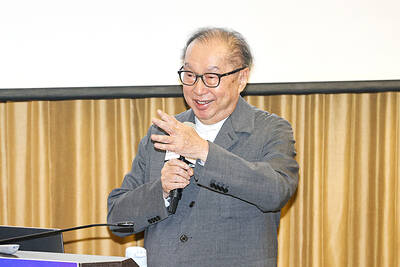AU Optronics Corp (AUO, 友達) yesterday reported 80.8 percent annual growth in net income of NT$8.88 billion (US$293.76 million) for last quarter and said steady and robust LCD panel demand is likely to extend into this quarter.
Last quarter’s results made it the fifth consecutive profitable quarter for the firm, one of the nation’s largest LCD panel makers.
Gross margin was 17.5 percent last quarter, up 4.35 percentage points from 13.15 percent in the same period of last year, while operating margin rose by 4.4 percentage points annually to 11.1 percent.
“The LCD panel industry is expected to continue growing healthily this quarter. We estimate AUO’s production utilization can maintain a high level similar to previous quarters’,” AUO chairman and chief executive officer Paul Peng (彭双浪) told a teleconference.
Production utilization rate was above 90 percent last quarter, the company said.
Peng said some people might doubt his optimism about the supply and demand situation this quarter, as China’s TV shipments dropped as much as 16 percent annually during China’s long National Day holiday at the beginning of this month.
However, investors should focus on the shipments breakdown in the Chinese market, Peng said, noting that contribution from the 50-inch and larger TVs accounted for 56 percent of the total TV shipments the Chinese holiday.
The 4K-resolution TVs, including larger TVs, contributed a record 73 percent of the total shipments in the Chinese market, Peng said.
“It indicates a rising demand for the higher-specification, larger and more value-added TVs in China, which is a positive sign for the industry,” Peng said.
Market trends in China also benefit AUO, as those kinds of products are the company’s main focus, he said.
Supply and demand for global LCD panels is expected to grow by between 5 percent and 7 percent next year, which would lead to a relatively healthy balance despite plans by some of his firms’ Chinese peers to expand their production capacity, he said.
China’s largest LCD panel manufacturer, BOE Technology Group (京東方), is set to ramp up its first 10.5-generation plant in the first quarter of next year, while China Electronics Panda Crystal Technology Corp (中電熊貓) plans to begin mass production of two 8.6-generation lines.
Given that BOE’s new production line is to be the world’s first 10.5-generation line and China Electronics Panda Crystal is new to the LCD panel industry, Peng said he believes both firms are going to face longer learning curves before they can deliver high yield products, which means their new production lines would have a limited impact to the industry next year.

BYPASSING CHINA TARIFFS: In the first five months of this year, Foxconn sent US$4.4bn of iPhones to the US from India, compared with US$3.7bn in the whole of last year Nearly all the iPhones exported by Foxconn Technology Group (富士康科技集團) from India went to the US between March and last month, customs data showed, far above last year’s average of 50 percent and a clear sign of Apple Inc’s efforts to bypass high US tariffs imposed on China. The numbers, being reported by Reuters for the first time, show that Apple has realigned its India exports to almost exclusively serve the US market, when previously the devices were more widely distributed to nations including the Netherlands and the Czech Republic. During March to last month, Foxconn, known as Hon Hai Precision Industry

Taiwan Semiconductor Manufacturing Co (TSMC, 台積電) and the University of Tokyo (UTokyo) yesterday announced the launch of the TSMC-UTokyo Lab to promote advanced semiconductor research, education and talent development. The lab is TSMC’s first laboratory collaboration with a university outside Taiwan, the company said in a statement. The lab would leverage “the extensive knowledge, experience, and creativity” of both institutions, the company said. It is located in the Asano Section of UTokyo’s Hongo, Tokyo, campus and would be managed by UTokyo faculty, guided by directors from UTokyo and TSMC, the company said. TSMC began working with UTokyo in 2019, resulting in 21 research projects,

Ashton Hall’s morning routine involves dunking his head in iced Saratoga Spring Water. For the company that sells the bottled water — Hall’s brand of choice for drinking, brushing his teeth and submerging himself — that is fantastic news. “We’re so thankful to this incredible fitness influencer called Ashton Hall,” Saratoga owner Primo Brands Corp’s CEO Robbert Rietbroek said on an earnings call after Hall’s morning routine video went viral. “He really helped put our brand on the map.” Primo Brands, which was not affiliated with Hall when he made his video, is among the increasing number of companies benefiting from influencer

Quanta Computer Inc (廣達) chairman Barry Lam (林百里) yesterday expressed a downbeat view about the prospects of humanoid robots, given high manufacturing costs and a lack of target customers. Despite rising demand and high expectations for humanoid robots, high research-and-development costs and uncertain profitability remain major concerns, Lam told reporters following the company’s annual shareholders’ meeting in Taoyuan. “Since it seems a bit unworthy to use such high-cost robots to do household chores, I believe robots designed for specific purposes would be more valuable and present a better business opportunity,” Lam said Instead of investing in humanoid robots, Quanta has opted to invest